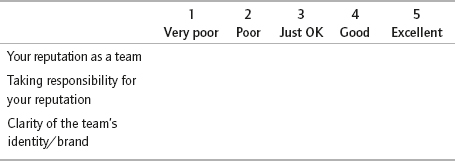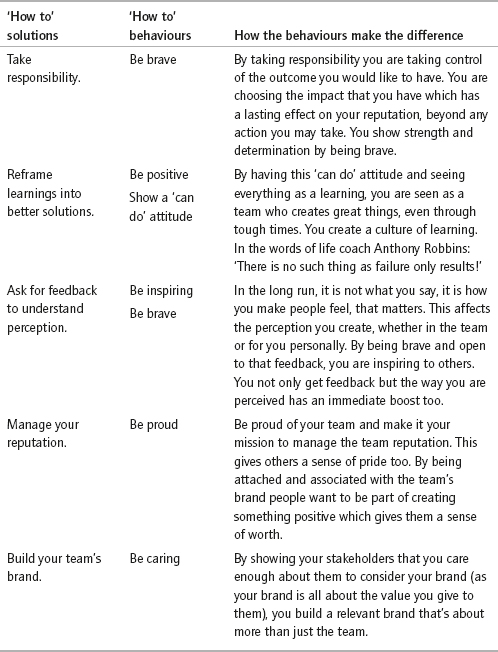chapter 7
How do you create a team that delivers and is well perceived?
- Increasing team’s awareness of how they are perceived
- Increasing level of responsibility for team delivery and team brand
‘I’ve learned that people will forget what you said, people will forget what you did, but people will never forget how you made them feel.’
Maya Angelou
Self-assessment
Before reading the chapter, do the following quick self-assessment.
How would you rate the following in your team?
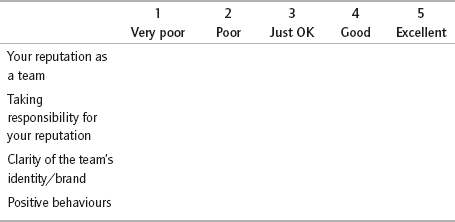
Mission impossible
Roger’s team was invisible. Everyone knew that they were a system development team, but they kept such a low profile that no one really knew what they were working on until they were nearing an implementation. Then all of a sudden everything was a big rush with communications filled with stress and impossible deadlines.
The latest such communication had landed in the inbox of James, head of finance. He read the request for yet more last-minute, urgent action that was needed for finalising the technical specification. He could feel his face getting hot and red with anger. As this was not the first time he had been given a mission impossible by Roger and his team, he decided that enough is enough and he needed to talk to Roger face to face.
He stomped down the corridor, full of determination. When he got to Roger’s office, he knocked and went in without waiting for permission.
Roger was busy as always, but looked up with surprise as James entered.
‘Hi James. I’m in the middle of something here, how can I help you?’
James’ ensuing monologue left nothing unsaid. He expressed his frustration with the constant last-minute requests that were impossible to meet. He questioned the way Roger’s team was working when everything seemed to be a fire drill.
Roger listened carefully and tried not to get defensive, but inside he felt like his leadership was being attacked. It was not a good feeling.
‘Well, I don’t know. I’ve been so busy. I need to check with my team. I’ll get back to you.’
James curtly nodded, spun around and left the room. ‘Yes, do that.’
Roger called his team together straightaway and explained that Finance was infuriated with the request they had received.
The team members started talking over each other, recognising that the timeframes were tight but having been so busy as always, they didn’t think they could have done anything differently. The team continued to blame another team and an external partner for not having provided them with critical information on time. His team was basically saying that it was not their fault. At some point in the conversation they started pointing a finger at Roger too, surprised at his outburst, wondering why he hadn’t spoken up earlier if this was seen as a reoccurring problem.
Reluctantly he had to take on their point. He was embarrassed. He should have taken control sooner.
Later that day, Roger got a phone call from Felicity, the marketing manager who was now a trusted peer.
‘Hey Roger. I need to talk to you. I’ll get straight to the point. I think your team’s and therefore your reputation is being damaged by this latest project you’re working on. There’s a lot of noise around how you are handling this and a sense of blaming that’s not doing you any favours.’
Roger sighed. This day was not getting any better.
Exploring the problem
Roger’s team is not doing a good job at communicating progress regularly. They only communicate when they really need something, which then appears urgent to others who weren’t kept in the loop of how things were going.
Reputation
Late requests for input create stress and irritation in those who feel they’ve been given a mission impossible. This irritation makes them less willing to co-operate. And now, Roger’s team is starting to get a reputation as a team who doesn’t know what they are doing. The team, as well as the individuals in the team, potentially now have their credibility questioned.
The last-minute approach has been building over time, and has therefore come to a head for James. He loses his temper with Roger. When anger is involved, rationality is no longer present and constructive outcomes are hard to get to.
Blame
Roger feels attacked and defensive, even if he’s trying not to show that. He turns some of his frustration, the mild form of anger, on his team who start blaming others rather than taking responsibility for their impact.
As this shows, a team that is not delivering as expected will also not be well perceived. And a team that is not well perceived, gets a bad reputation. And from a bad reputation, it’s hard to get the trust and co-operation from others, which they need to be able to do their job well.
The reasons for teams not delivering and not being well perceived
They are not able to do their job
If team members are lacking the skills or the tools to do their job, it is difficult for them to deliver as expected. This can also be a reflection of them not being able to do the job to the best of their ability, if it’s too scripted, not making the best use of each person’s specific strengths and capabilities.
They don’t work well together
A team that lacks in trust and/or teamwork will find it hard to do their jobs as effectively as they could, working side by side but not necessarily together.
They don’t know what’s expected of them
Without clear roles and responsibilities, goals and expectations, team members do very little or they do what they individually decide could be expected of them. They may even make team assumptions of what they are expected to do, which could take them off track.
They miss deadlines
Delivering to expectations and plans is crucial for trust. If a team keeps missing deadlines for any of the reasons listed here, their reputation will be impacted.
They make excuses and are not prepared
Excuses are never fun to listen to. When team members are not prepared, they often fall back on making excuses as to why something hasn’t been done or done properly.
They are not correctly estimating what the job involves
When team members are quick to jump to action, they may not have taken the time to assess what it will take to complete the task. They end up overwhelmed and unable to deliver while the clock is ticking.
They demonstrate negative behaviour
Team members who blame others and circumstances for not delivering as expected, erode the trust others could have in them. This is also true when others can observe ongoing conflict in the team, when team members talk behind each other’s backs, and it is not dealt with or resolved by the leader or team members.
They don’t tell people what they are doing
Teams that keep to themselves or don’t think about the importance of managing their stakeholders, or communicating regularly, can find themselves without the support they need to be able to perform.
The impact of not delivering and not being well perceived in teams
- When a team is not delivering, others don’t want to work with them or be dependent on them. Not delivering makes the team poorly perceived. It creates a lack of trust and the team gets a bad reputation.
- It’s harder for the team to do their work when collaboration is withheld.
- It’s harder to recruit into the team when there is reluctance to join.
The impact on the business, customers, employees and stakeholders
When a promise of delivery is not met, relationships are negatively affected. People feel let down and disappointed. It leads to a lack of trust.
Teams with a bad reputation, who aren’t delivering, will make it hard for other teams to do their job, impacting the collaboration across the business. Even if asking for help, such a team may not get the help they need, further impacting the business delivery. People will not go out of their way to help them.
Employees’ behaviours and lack of delivery can be experienced both on the inside and from the outside of the business. When a customer is directly affected and don’t get what they’ve paid for, they may choose to take their business elsewhere.
It can affect the organisation’s brand overall and therefore its perceived value. A tarnished brand has a harder time attracting investors, customers and top employees. Not managing reputation and brand carefully can be very expensive.
If people feel too scripted or restricted in how to carry out their job, delivery is likely to be negatively impacted, as is employee engagement.
A team who were part of a large multinational organisation was known for constantly being busy and putting out fires. They moved from fire drill to fire drill. They jumped from action to action and simply reacted to requests. Their results were unpredictable and other teams were unsure of them so they avoided doing any work with them unless they absolutely had to.
The team was seen as always reacting and responding rather than being proactive. It was hard to work with them. This ‘fire drill’ behaviour stopped them from taking time out to plan ahead and get out of this reactive state. Others were not confident in their delivery so the reputation of the team was not positive and word got around the organisation quickly.
The impact was even worse, as the leader of the team then got fired and this set back the team even further. It also cost a lot of time and money to rebuild the team along with its reputation and trustworthiness.
Solutions
It’s human nature to want to have some level of autonomy. When wanting a team to deliver well, this is one of the strategies worth considering. Think about giving your team members as much freedom as possible to do their job in the way they want to do it, making it possible for them to deliver at the top of their ability.
Ultimately it’s about creating various opportunities for teams to be able to perform well and create a good, solid impression.
Let’s get specific on how to do it.
Solution 1: Performance management
Getting a team to perform is one of the biggest responsibilities of a leader. It comes down to setting goals with the team members, in line with the vision of the organisation.
Great goals put equal importance on WHAT and HOW. The performance management system must have a rating for achievement of goals as well as a behaviour rating.
And once these goals are set, creating plans as to how the goals will be achieved, what to do to get there. This also involves equipping the members to achieve the goals, identifying strengths to use and areas to develop. Then follows regular coaching and follow-up, to ensure the person can perform to plan. It’s a continuous loop.
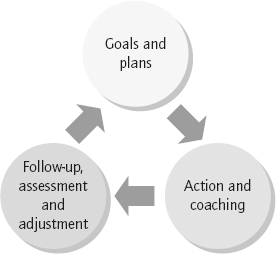
Figure 7.1 Performance management
Solution 2: Success habit creation
Creating a success habit can work well for a team who needs to focus on turning something from a negative into a positive. It is commonly agreed that it takes at least 21 days to make a habit and 21 days to break a habit. By creating a habit of success it means you are focusing your time and energy on something you want, NOT something you don’t want. For example, if you want to create a habit of meeting deadlines you need to put an emphasis on it and build a plan to make it work. There will be members of a team who are driven to hit deadlines and will work very well at achieving them, so use the person(s) in the team with that skill and use their methodology to help the other members of the team to build a success habit for meeting deadlines.
Review the success habits in your team and build habits for the whole team to follow. Use accountability buddies to hold each other to account on your success habit plans.
Solution 3: Take responsibility
Take responsibility for the team’s reputation. Use the ‘moment of truth’ to think about your responses. This is the moment where we make a choice. That choice determines the results we get at any given time. This applies to you personally or to you as a member of a team. As the diagram below illustrates, the moment between the stimulus – when someone makes a comment – and the response you make – is the ‘moment of truth’. This is where you choose how to respond. It is only a moment, a second or even a blink of an eye, but this is the opportunity you have to choose to respond in a way that affects the impact you have in a constructive way. Responses don’t have to be automatic, but due to our habits of thought, they often are, unless we take control.
As a team, choose that ‘moment of truth’, rather than being run by your ‘team autopilot’, to ensure you are improving the perception of the team. Every moment counts.

Figure 7.2 Moment of truth
Take responsibility also for the decisions that you make as a team. If you’ve made a decision, you need to stand by that decision as a team, backing each other up, not going off and doing something other than what was agreed.
Solution 4: Reframing learnings into better solutions
Teams can learn something new every day. There is great power in taking learning from a situation and turning it into a better solution. This is called reframing, simply seeing all results as learning. Each team member can reframe outcomes and results. Reframing is also an excellent way of being seen as delivering, it helps other people to experience the positive way forward. A team who builds a culture of reframing can do so simply by seeing things differently and communicating that each stage is a learning to take you to something better, even greater.
Start reframing in your team and take on board all the learning. Hold a learning set, and focus on talking about what you need to reframe or learn from.
There was a team who were breaking new ground in the work they were carrying out. Everything they did was new and no one else had previously done it. They were not attached to the activities they were implementing or carrying out. They simply kept trying new things to create greater results. The reputation they had was that they were very successful and everything they did was seen as a positive step forward. People even quoted them as a team that pretty much got it right all the time. They were highly respected.
They didn’t get it right each time though. It was just the way they reframed it when it didn’t go the right way, which made it look that way. The team knew they had to break new ground and to do that they would have to make some errors along the way. They saw those errors as learning opportunities and the learning helped them to get it right. They were both positive and realistic, which made people feel connected to them and what they were trying to achieve. This translated into them being seen as highly successful. And they were, but only because they dared to try things and not get beaten down by setbacks on the way.
Solution 5: Ask for feedback to understand perception
Go and find out what the perception of the team is. Ask people what they think of your team, ask them for feedback. Use this simple four-step method:
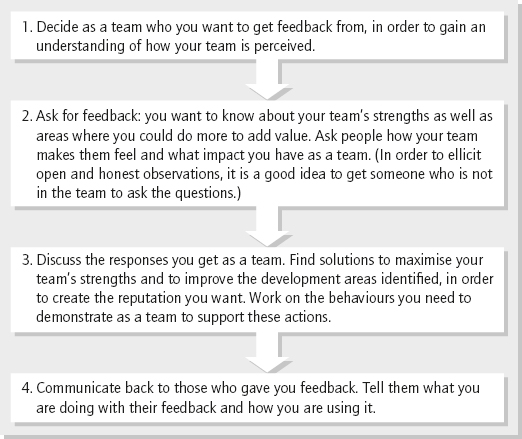
Figure 7.3 Feedback for the team
Solution 6: Manage your reputation
How a team is perceived creates their reputation, which needs to be managed rather than left to chance. Each team has an image whether they manage it or not, so take control of that image and reputation. Consider your stakeholders, what they expect, what you deliver and hence what your reputation becomes. And if you have already implemented solution 5, you will have plenty to kick-start the discussion with.
Ask your team these questions:
- How is our team perceived?
- If we were to ask others about our team what would they say? Would it be positive and constructive? Do we know this already?
- What behaviours do the team demonstrate that are useful and not useful? What is the impact on others?
- How would you describe the relationship between this team and its customers, both internal and external?
Solution 7: Build your team’s brand
A brand is a concept, an expectation, which lives in the head of the customer.
In general, you could say that the brand is made up of the product itself, the service that surrounds it and the communication that’s used about it. When all these things are added together, an experience is created, a promise of what the customer can expect, which can be called a brand promise. And a team has both brand and brand promise.
As a team, think about why it is important to work on the brand the team has. To be successful it is very important to be a reliable partner for your internal and external stakeholders, to deliver a good experience. So, if you’re not doing it already, think of others in the organisation as the customer. This thinking changes the mindset, it puts you into a different frame of thinking. Would you treat external customers the way you do internal colleagues? What if you treated internal colleagues like customers? And what if you treated your employees like customers?
Here are some discussion questions for your team:
- How clear is our team identity/brand?
- How much do people know about what we do? How are we communicating about our ‘brand promise’ and delivery?
- How could we raise the profile of our team?
- In what way would it change the perception of our team if we treated our internal colleagues like customers?
Let’s have a look at what Roger could have done instead, had he deployed these solutions.
Roger had thought a lot about his team and how they were being perceived by others. He had discussed the subject with his team in depth, and they had all agreed that it was crucial to their success to become more proactive in their way of working. One of his team members had been given the overall responsibility of communication. This meant they now had a communication plan, which carefully tracked all relevant stakeholders and how they needed to be involved and communicated with, through the complete cycle of a project and its implementation.
And the results were very encouraging. The ease of the latest implementation had been praised by a number of people around the organisation. The feedback he was particularly pleased with was the pat on the back he had received from James in Finance, who was known for his structured approach, rarely matched by others.
All our lives are so much easier these days, I actually feel in control and so much calmer.
It makes me wish I had taken this proactive approach to my team earlier, but better late than never!
Behaviours of team and leader
Under ‘Solutions’ above, we have listed a number of ‘how to’ actions. These solutions work best when carried out with these supporting ‘how to’ behaviours. The actions on their own will get you only so far. With the right behaviours you can create a team that delivers more effectively and is well perceived.

Thoughts and feelings of team and leader
On average, a person experiences around 70.000 thoughts per day.1
Many of those thoughts are habits that affect a person’s mindset or outlook.
What we think affects how we feel, and how we feel affects how we think.
When wanting to ensure that a team delivers and is well perceived, actively replace thoughts and feelings that are counterproductive to that. Here are thoughts from the story, their impact on feelings and how they can be changed.
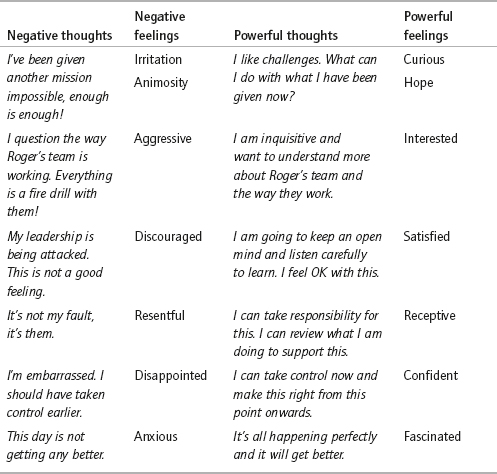
Summary
Every team has a team brand, an image and a reputation, created by the actions and behaviours of the team and its individuals. And a large part of that perception is driven by how well the team delivers on expectations and promises made.
As a team you need to make sure that everyone understands and takes responsibility for their role in creating the perception of the team, which includes both what is delivered and how it is delivered (e.g. on time, respectfully and professionally).
As a leader of a team, you need to create the environment and infrastructure that allows for the team to deliver to expectation.
‘A leader is not necessarily the one who does the greatest things, it is the one that gets the people to do the greatest things.’
Ronald Reagan
Reflection questions for the reader
- How much responsibility am I taking for my own and my team’s reputation?
- How well does my team deliver to deadlines?
- To what degree do I make excuses when I or my team don’t deliver as expected?
- How much am I proactively creating success habits to ensure delivery?
Self-assessment
After you have implemented the solutions in this chapter, answer these questions again to see the progress you have made.
How would you rate the following in your team?
